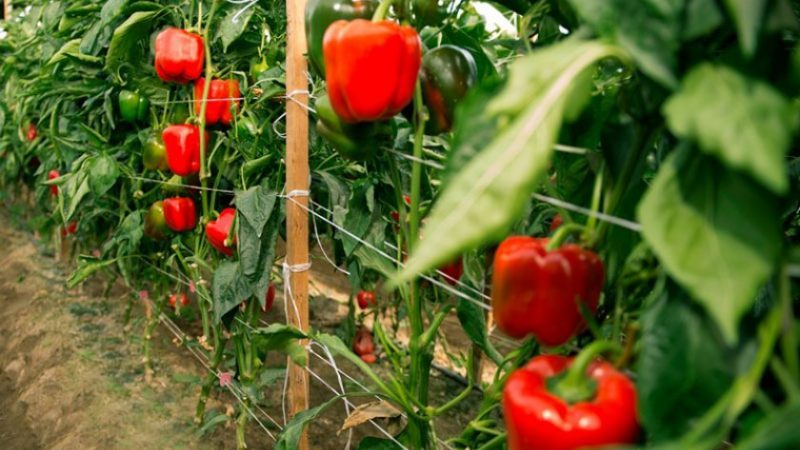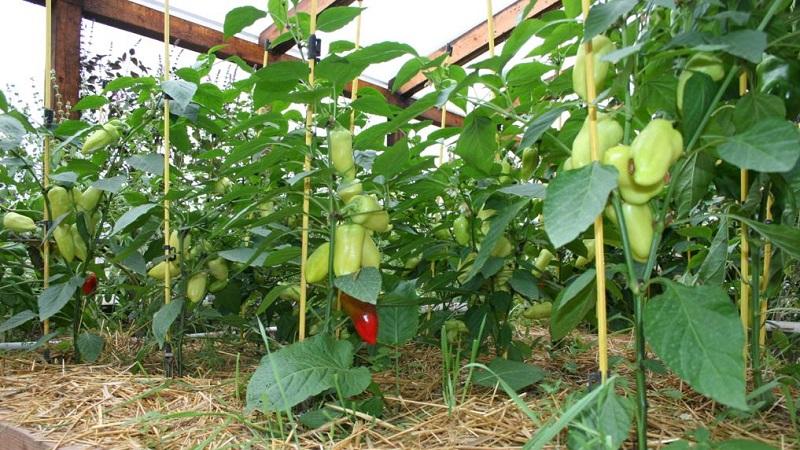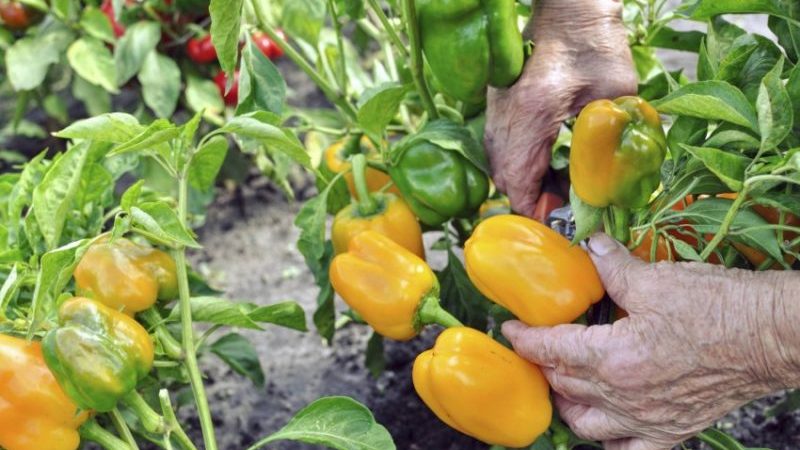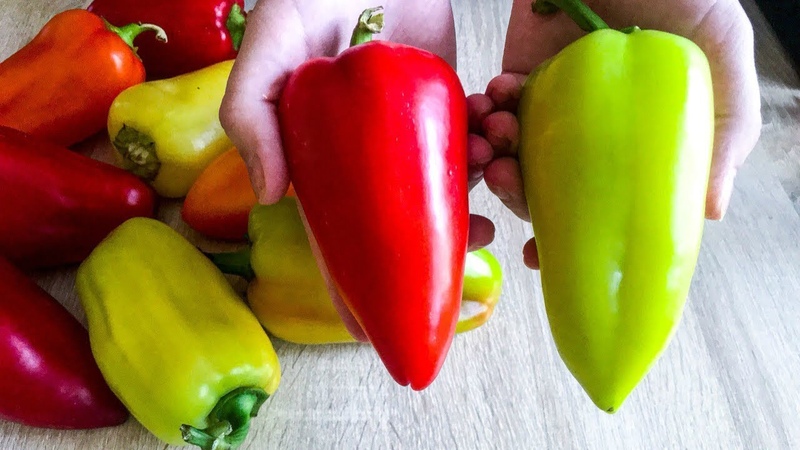When to remove peppers in a greenhouse: determine the degree of maturity of the crop and collect it correctly and on time
Many farmers are concerned about the question of when and how to properly harvest pepper in a greenhouse. To do this, it is necessary to understand the degree of ripeness of the fruit, since an untimely cut vegetable will not be stored for a long time. You also need to know the basic rules for collecting vegetables so as not to damage the bush and give it the opportunity to bear fruit.
We will talk about this and much more in our article.
The content of the article
When to shoot peppers in a greenhouse
Pepper is a thermophilic plant. For high-quality growth and fruit formation, the plant is provided with a temperature of + 20 ° C ... + 28 ° C. At + 13 ° C ... + 15 ° C, the plant stops developing, with a further decrease in it, the bush dies. Therefore, harvesting in greenhouses begins in July and ends before the air temperature drops to + 15 ° C.

Terms of collection and what they depend on
The final harvesting of the pepper is carried out in the fall, before the onset of frost. The harvest time depends on the ripening period.
Varieties with an early ripening period begin to be cut after 3 months from the moment of planting. The ripening period of mid-season varieties occurs at 110-130 days. Late-ripening varieties ripen for more than 130 days.
The harvest time also depends on the purpose for which were grown vegetables.
Attention! If the fruits are intended for long-term storage, they are harvested at the technical stage of ripeness.
Fully ripe vegetables are stored for no more than 7-10 days in the refrigerator. They are eaten during this time.
Lunar collection
Gardeners who adhere to the rules for planting and collecting vegetables according to the lunar calendar know that certain phases of the moon affect different plant organs.
Reference. Peppers are harvested on the day of the zodiac sign that affects the fruit.
If a shoot pepper on the growing moon, it is recommended to eat it immediately. The harvest collected at this time will not be stored for long.
The lunar calendar indicates the "days of the fruit" - the time when the moon is in the signs of Aries, Leo and Sagittarius. This is an auspicious period for picking pepper. It is not recommended to harvest on days when the Moon is in the signs of Capricorn, Pisces, Cancer and Virgo.

How to determine the degree of maturity
Farmers distinguish between technical and biological maturity of pepper. The first, called removable, harvesting, occurs 1-1.5 months after the formation of ovaries... At this time, the fruits were fully formed, but did not reach the color characteristic of the variety. The second degree is physiological, when the vegetables have acquired the color corresponding to the variety.
External signs and method of verification
Unripe vegetables are pale green or dark green in color, insufficient length and diameter of the fruit. The walls of unripe vegetables are thin - 0.3-0.4 cm. The seeds of such peppers are undeveloped and are in a state of milk maturity.
In the harvesting, removable stage, the pepper corresponds to the varietal characteristics, but its color is not yet bright enough, their seeds are not ripe. These fruits are suitable for consumption, long-term storage and sale. At home, in sunlight, they ripen quickly.
At the onset of real maturity, the pepper has a bright, characteristic color for the variety: rich green, yellow, orange, red, purple. The seeds are fully ripe and ready for planting.
A sign of full ripeness is the wall thickness of the pepper 0.6-1.3 cm.
Ripe vegetables acquire juiciness, taste corresponding to the variety, they contain the maximum amount of vitamins, macro- and microelements, useful substances.
Reference. The main indicator of the ripeness of the pepper is a characteristic crunch with light pressure on the walls.

What are the degrees of maturity
Pepper has two stages of maturity.
Technical - characterizes the end of fruit formation, occurs on average 60 days after the beginning of the growing season. Fruits do not fully ripen, have a greenish color, from pale to dark green, depending on the variety. At this stage of ripening, vegetables are harvested for long-term storage, many hours of transportation.
Biological - physiological (full, real) ripeness. The fruit has reached all the characteristics of the variety: color, taste, size, appearance. The color of the pepper in the biological degree of maturity becomes saturated, bright: red, orange, yellow, yellow-green, purple. The fruits acquire the taste characteristic of a particular variety.
Reference. The ripening period of pepper from technical to biological ripeness is 23-30 days.

How to accelerate ripening
The question of how to accelerate the ripening of peppers in a greenhouse worries gardeners in early autumn, when cold nights approach. To do this, use different methods:
- In order for the fruits to ripen on time, barren flowers are removed during the entire growing season, excess shoots are pinched.
- At the end of August, remove all flowers and small peppercorns that do not have time to ripen. This will enable the bush to focus all its energy on the formation of the remaining vegetables.
- To make the fruits ripe faster, the top is cut off the bush.
- When cold weather approaches, the bushes are covered with agrofibre at night.
- To accelerate the ripening of fruits, they watered warm water heated to + 40 ° C.
- Foliar gives good results. feeding phosphorus and potassium, ash infusion.
- So that the bush does not waste energy on ripening ripe vegetables, they are cut off at the onset of technical ripeness.
How to harvest correctly

During harvesting, with careless movement, the bush breaks easily, it has very fragile branches. Therefore, they follow the rules:
- The fruits are cut along with the stalk with a pruner, while holding the stalk with your hands. The absence of a peduncle shortens the shelf life of the fruit.
- From the end of July, vegetables are cut as they ripen every 3 days.
- At the stage of technical ripeness, vegetables become elastic, dense, acquire a glossy shine. Such fruits are cut - they are considered ready for harvest.
- After every cut of vegetables tear off the lower leaves on the stem... This stimulates the ripening of the pepper.
Harvest preparation for storage
To keep the harvest as long as possible, the fruits are prepared for storage. In order not to damage the vegetables during collection, they are not cut off, but carefully cut from the bush with pruners.
For peppers intended for long-term storage, the stalk is not removed.
Peppers are sorted after harvest. Ripe fruits are used for food immediately, they are not stored for a long time. Cracked, dented, pest-damaged vegetables are washed, cut off damaged areas and used first. They are also cut into pieces, placed in bags and stored in the freezer.
Healthy, undamaged specimens selected for storage are wiped with a damp cloth and laid out on a dry surface to dry completely. Before storage, the stalk is shortened, but not completely cut.
With a large harvest, the pepper is sprayed with a 1% solution of copper sulfate, dried, and stored.
Storage methods
For long-term storage of technically ripe peppers, small containers are used, in which vegetables are placed in 2-3 layers. They are transferred to a room with an air temperature of + 1 ° C ... + 3 ° C and a humidity of 80–85%. Under these conditions, the pepper is stored for 2 months.
Fully ripe vegetables retain their taste for three weeks at + 10 ° C ... + 13 ° C and high humidity of 85-90%.The best place to store such fruits would be a basement or cellar.
Attention! No light should enter the room, otherwise the fruits will begin to ripen, the shelf life will be reduced.
Green bell peppers, which have not reached real ripeness, retain their fresh appearance and elasticity until the new year, subject to the recommended storage conditions.
To store unripe peppers, use cardboard boxes or wooden boxes. All containers must have side holes so that the fruit does not "suffocate". Thick paper is laid on the bottom of the container. Vegetables are spread in 2-3 layers, sprinkled with dry sand, sawdust.Good results are obtained by wrapping each vegetable in clean paper.
When storing ripe peppers in the refrigerator, the fruits are packed in plastic bags or wrapped in cling film. To extend the shelf life, the peel is lubricated with sunflower oil, resulting in a protective film. It allows you to keep the fruit fresh during storage.

When the pepper begins to rot, the damaged areas are removed, peeled from the core, seeds. Then the walls of the fruit are cut into pieces, small portions are wrapped in cling film. In this form, the pepper is stored in the freezer for 5-6 months. With a longer period, the pepper loses its taste, aroma and useful properties.
Oven dried bell peppers have a long shelf life. Cut peppers without a core are laid out on a baking sheet, dried for 7-9 hours at a temperature of + 50 ° C .. + 55 ° C. Dried peppers are stored in a dry place in hermetically sealed containers and jars.
Bitter peppers have thin walls, they are dried in the sun, strung by the tail on a rope, for 6-8 days.
Attention! Only fully ripe red pods are suitable for drying.
After drying, hot peppers are stored in a dry room in sealed containers or hung on ropes in the kitchen.
Conclusion
Collecting peppers in a greenhouse is a simple process. It is important to correctly determine the degree of maturity of the crop and know the technology of its harvest. From that grown Whether the pepper is stored or eaten immediately depends on the harvest time. Timely collection of ripe fruits will help maintain the strength of the bush for ripening the remaining green vegetables on the branches.